This article was first published in the Concorso Italiano Program – August 15, 2015.
by Mike Gulett
Renzo Rivolta, the founder of Iso S.p.A. Automotoveicoli, an Italian automobile manufacturer, was a visionary. After the devastation heaped upon Italy by WWII he saw the need for inexpensive transportation for Italy and all of Europe. He began manufacturing scooters, motorcycles, small trucks, the Isetta mini-car (made famous by BMW who licensed the design from Iso) and eventually Gran Touring (GT) cars, which featured Italian styling and American power.
The pinnacle of the Iso GT car is the beautiful Grifo. More and more car lovers have recognized the Iso Grifo in recent years as a great GT that compares very favorably to period GTs from Ferrari, Maserati, Lamborghini and all other GT manufacturers. This helps explain a dramatic increase in the value of the Iso Grifo over the last few years, which has kept pace with, or exceeded, the market appreciation for collectable cars.
The Iso Grifo A3/L, as the one-off prototype was named, debuted at the Turin Auto Show in 1963 along with a similarly named Iso Grifo A3/C, which had a lightweight riveted aluminum alloy body. The ‘L’ in A3/L stands for lusso (luxury) and the ‘C’ in A3/C stands for corsa (race). For such a small difference in the name there was a huge difference in the appearance and purpose of the two cars. The A3/L, which is here at Concorso Italiano, is a full luxury sport GT car for two. The A3/C is a racecar designed for the sole purpose of winning the 24 Hours of Le Mans where it did win the 5-Liter and above class, finishing 9th overall in 1965.
The combination of the vision of Renzo Rivolta, the engineering expertise of several key Iso employees like Pierluigi Raggi, the technical contributions of Giotto Bizzarrini (the engineer in charge of the development of the Ferrari 250 GTO) and the brilliant styling of Giorgetto Giugiaro of Bertone resulted in one of the most admired sports cars of the past fifty years. Nuccio Bertone also played a critical role in the creation of the Iso Grifo.
There was confusion at Iso about what to do next after the Rivolta GT (the 2+2 family car). Bizzarrini was pushing for a two-seat sports car and he really wanted to build a racecar. Renzo Rivolta, as a businessman, was concerned about the financial wisdom of building a sports GT car that only held two people. He was also concerned about the development cost.
The berlinetta (Berlinetta?) design style (a small sedan or fastback) became popular and important in the 1950s and 1960s because a well-designed berlinetta just looked fast and sexy. Ferrari and the design house Pinin Farina (now Pininfarina) mastered the berlinetta style and had led the way. Bertone had also mastered the berlinetta design and wanted to continue their close relationship with Iso by designing a very special berlinetta.
Nuccio Bertone was so committed to this idea for the next Iso GT that he offered to do the work. Renzo Rivolta saw the wisdom in this suggestion and thus Nuccio Bertone was key in making the Grifo a reality. Bertone even came up with the Grifo name.
The Grifo was built using a shortened Rivolta GT chassis (which was designed by Pierluigi Raggi and Giotto Bizzarrini) with Nuccio Bertone taking the responsibility to build the prototype based on a rolling chassis and mechanical components sent to Bertone by Iso. Bertone built the Grifo A3/L and the one-of-a-kind prototype was displayed on the Bertone stand at the 1963 Turin Auto Show. This was a huge attraction for Bertone, exactly what Nuccio Bertone had in mind.
The Iso Grifo A3/C was displayed on the Iso stand at the same Turin Auto Show. This was quite a coup for a small company such as Iso to introduce two stunning cars at the same show. One was a beautiful sport GT car and the other would go on the win it’s class at the 24 Hours of Le Mans two years later. The Iso A3/C was also one of the fastest racecars on the straight away at Le Mans hitting 190 MPH in 1965.
The production version of the Iso Grifo A3/L incorporated a few style changes, was renamed the Iso Grifo GL and introduced at the Frankfurt Auto Show in 1965. The style changes were mostly aimed at cost reduction. That beautiful hood scoop on the Grifo prototype was just too expensive to manufacture. The Grifo GL was hand made with each body panel, fashioned by Iso not Bertone, being a little different on each car, as is the case with hand made items.
In the beginning both versions of the Grifo were powered by the Chevrolet Corvette 327 V8 engine and used the Borg-Warner 4-speed manual transmission. Giotto Bizzarrini has said that he liked the Corvette engine better than Ferrari engines of the day. The limited slip differential is a Salisbury with rear inboard disc brakes sitting alongside. Disc brakes were on the front as well.
The GL and the A3/C models use the same Raggi-Bizzarrini designed chassis with a different purpose for each model. The GL is a GT sports car designed to go fast in comfort and style while the A3/C is an all out racecar. The engine was pushed far back in the chassis for improved weight distribution on both models and taken to an extreme on the A3/C where it is placed so far back it is considered a front mid-engine placement. The A3/C distributor is under the dashboard and a removable panel on the dashboard is designed to help with access to the distributor. The engine in the GL sits several inches more to the front for the comfort of the driver and passenger but still well behind the front axle.
Each car had different body designs, both styled by Giugiaro of Bertone. The A3/C is low slung, very aerodynamic and made of light weight aluminum alloy. The GL sits higher for ease of entry and exit and provides more comfort to the driver and passenger. The GL has a steel body with an aluminum hood. The GL is a beautiful sport GT with a racing chassis that can be put to good use at speed on winding mountain roads or country lanes in comfort.
The Grifo A3/C models eventually were spun out of Iso into Giotto Bizzarrini’s own company and branded the Bizzarrini GT 5300.
In 1968 Piero Rivolta decided to produce a more powerful Iso Grifo and installed a Corvette 427 cid (7 liter) engine in a new model named the Grifo 7-Liter. The engine did not fit in the compartment intended for the 327 cid, so Iso designed the “pagoda” hood scoop to accommodate the larger engine. It is probably the most unusual hood scoop ever made and people either love it or hate it.
In 1970 a body design change was implemented; the headlights were partially covered in a style that was typical in the 1970s. This new body design is called the Series II while the original design is the Series I.
In 1972 Iso started using the Ford 351 Cleveland V8 engine with an Iso hood scoop that is slightly taller than the 7-Liter hood scoop.
There were a few Grifos brought back to the factory that were rebuilt, issued a new chassis number and sold again by Iso. The chassis numbering goes to 412, however there were only 402 unique Grifos actually made (not including the A3/C models).
The motoring press loved the Grifo GL and what’s not to love with Italian styling and American power – a great combination. The Grifo was considered the fastest production car one could buy in 1966.
Jerry Titus wrote in the “Sports Car Graphic” July 1966 issue, “There’s little doubt, once you’re seated behind the wheel, that the Grifo is a performance GT in every sense of the word. …we rate the Grifo as one of the top GTs in existence. It has some unique and practical features all its own, and the body styling gets our personal vote over all others that can be considered ‘production GTs’.”
“Autocar” on April 29, 1966 wrote, “ …it (the Grifo) is the ultimate in transport for the enthusiast, a kind of dream car come true. It brings back some of the lost pleasures of motoring and introduces many more new ones.”
John Bolster summed it up nicely in “Autosport” on August 12, 1966, “I have never driven a car of which the appearance attracted so much favorable comment…for the man who wants the ultimate in two-seaters, this is the best that money can buy.”
Renzo Rivolta died at the young age of 58 in 1966 and his 25 year old son, Piero Rivolta, took over the Iso company – the youngest major car company CEO in history.
Piero Rivolta had the bad luck to be in business at the time of the oil crisis of the early 1970s and the labor and political unrest of the 1960s and 1970s. These problems seemed especially troublesome in Italy, where the terrorists organization the Red Brigade, was kidnaping people who drove fancy cars. They also were trying to shut down industry by sabotaging factory equipment and breaking into factory buildings. They kidnapped industry executives, held them for ransom and murdered some of their captives including government officials.
Workers went on strike and shut down factories in Italy. This was a toxic environment for a small GT car manufacturer like Iso and there were no government bailouts to save them. The atmosphere in those times motivated people to drive low profile, boring cars to escape the notice of these terrorists. This was not good for Iso who was manufacturing exciting high profile GT cars.
Iso had the potential to be a long-term great car company but instead went under in 1974.
The company lives on today in the hearts and minds of car lovers who collect, drive, restore, race and show these great cars at events all over the world such as Concorso Italiano.
Grifo Models (number produced – 402 total)
Grifo A3/L (1)
The Grifo GL prototype.
Engine: Corvette 327 V8, 340 hp
Transmission: Borg-Warner 4-speed
Grifo A3/C (22)
This is a different body style than the Grifo GL, and eventually became the Bizzarrini GT 5300.
Engine: Corvette 327 V8, 365 hp, 405-420 hp
Transmission: Borg-Warner 4-speed
Grifo A3/L Spider (1)
One-off prototype.
Engine: Corvette 327 V8, 340 hp
Transmission: Borg-Warner 4-speed
Series I
Grifo GL 300 (77)
Engine: Corvette 327 V8, 300 hp
Transmission: Borg-Warner 4-speed; option, ZF 5-speed, Powerglide automatic or Turbo Hydromatic
Grifo GL 350 and 365 (165)
Engine: Corvette 327 V8, 350 or 365 hp
Transmission: Borg-Warner 4-speed; option, ZF 5-speed
Grifo S Targa (13)
Engine: Corvette 327 V8, 300 or 350 hp
Transmission: Borg-Warner 4-speed; option, ZF 5-speed, or Turbo Hydromatic
Grifo Super (1)
The prototype for the 7-Liter model.
Engine: Corvette 427 V8, 400-435 hp
Transmission: Borg-Warner 4-speed
Grifo 7-Liter (65)
Engine: Corvette 427 V8, 390-400 hp
Transmission: Borg-Warner 4-speed; option, ZF 5-speed, or Turbo Hydromatic
The “pagoda” hood scoop was made famous by the 7-Liter model.
Series II
The Iso Grifo Series II, introduced in 1970, was basically the same car as the Series I Grifo with the headlights partially covered.
Grifo IR 8 (17)
Engine: Corvette 327 V8 or Corvette 350 V8, 300 or 350 hp
Transmission: Borg-Warner 4-speed; option, ZF 5-speed, or Turbo Hydromatic
Grifo IR 9 Can Am (24)
Engine: Corvette 427 V8 or Corvette 454 V8, 400 or 390 hp
Transmission: Borg-Warner 4-speed; option, ZF 5-speed
The Can Am had a slightly taller hood scoop than the Series I 7-Liter model.
Grifo S Targa (4)
Engine: Corvette 327 V8, 300 or 350 hp
Transmission: Borg-Warner 4-speed; option, ZF 5-speed
Grifo (34)
Engine: Ford 351 Cleveland V8, 325 hp
Transmission: ZF 5-speed; option, Ford Cruise-O-Matic automatic
All photos by Mike Gulett and Bruce Caron from Concorso Italiano, August 15, 2015.
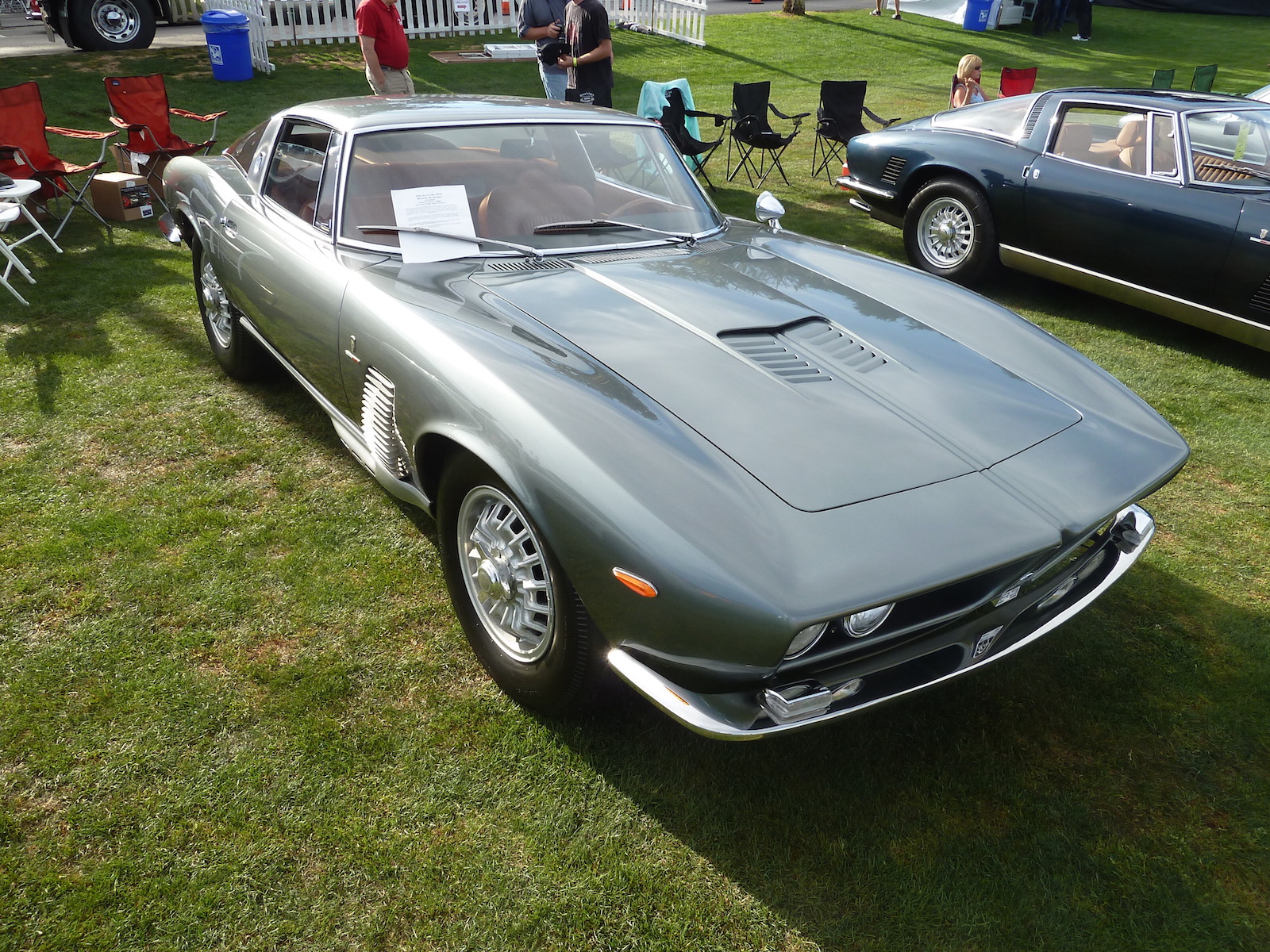
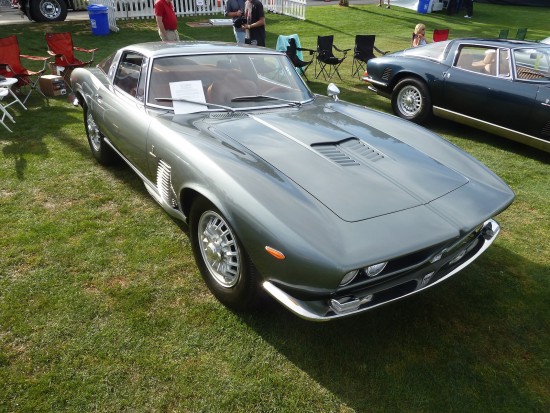
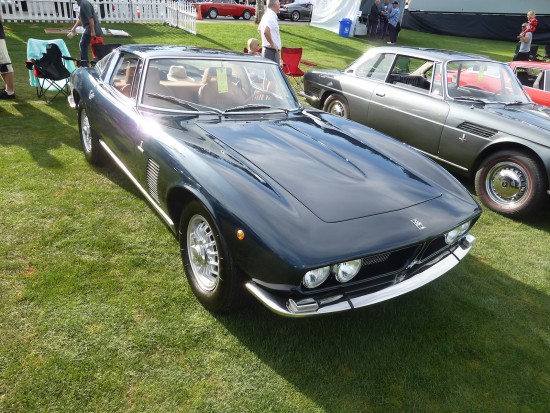
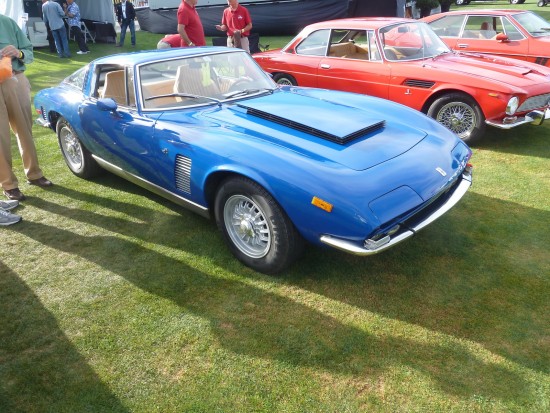
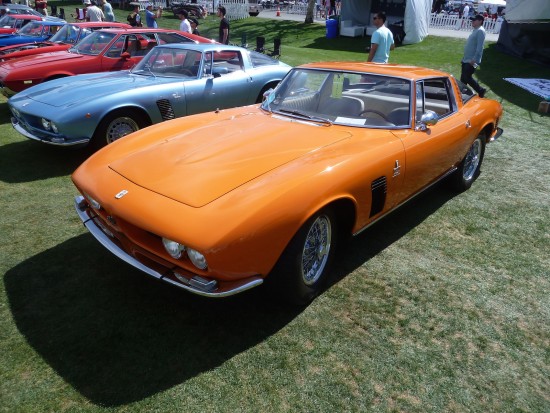
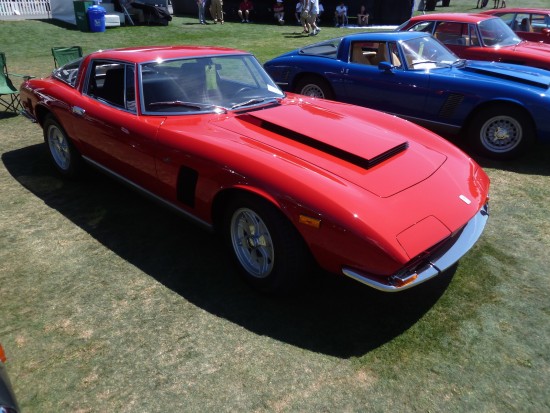
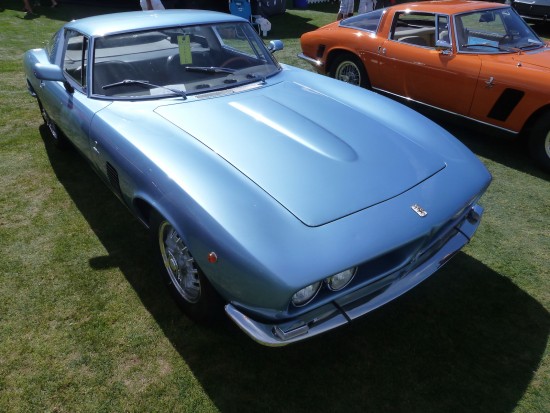
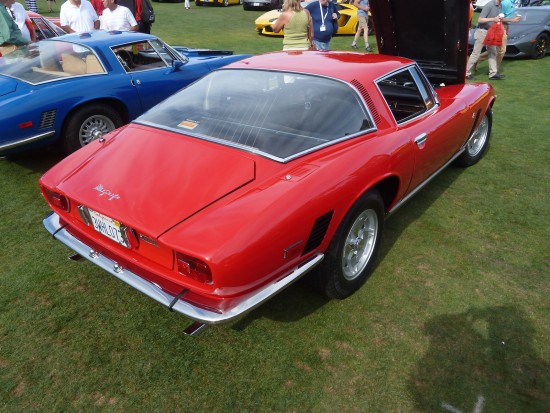
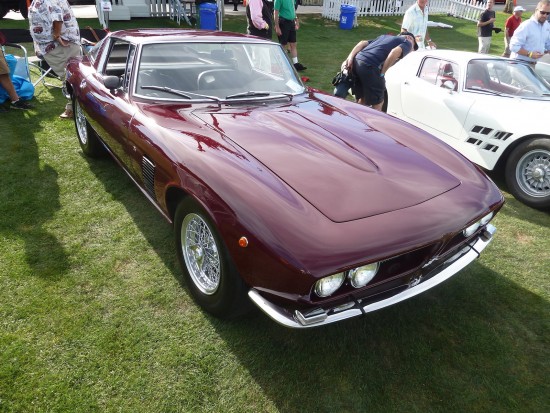
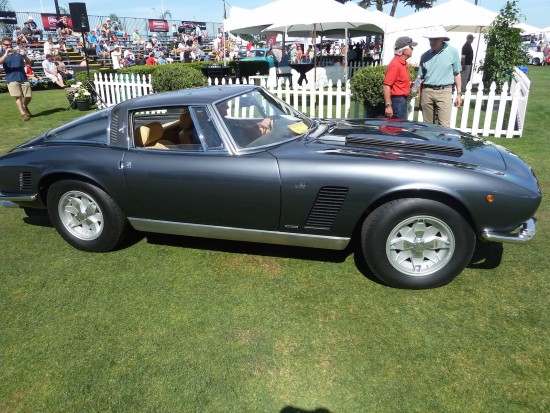
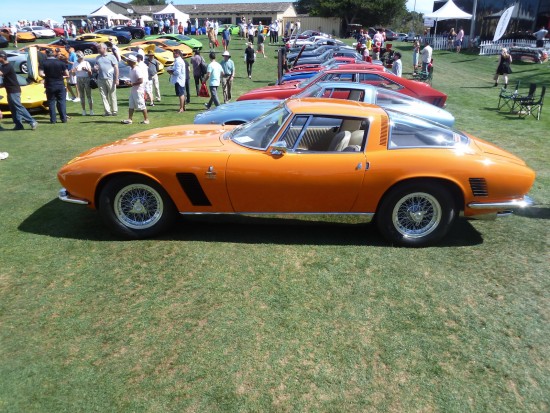
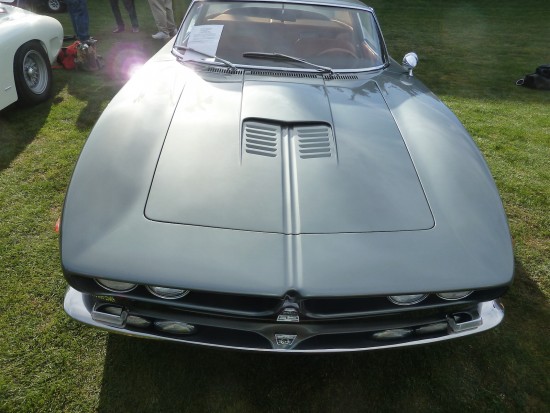


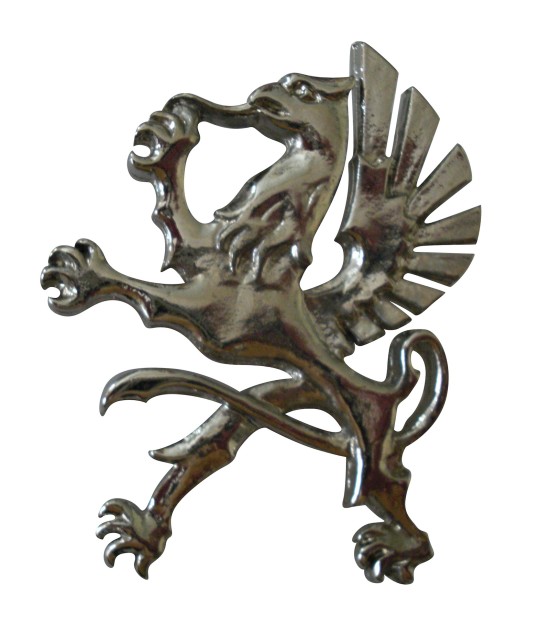
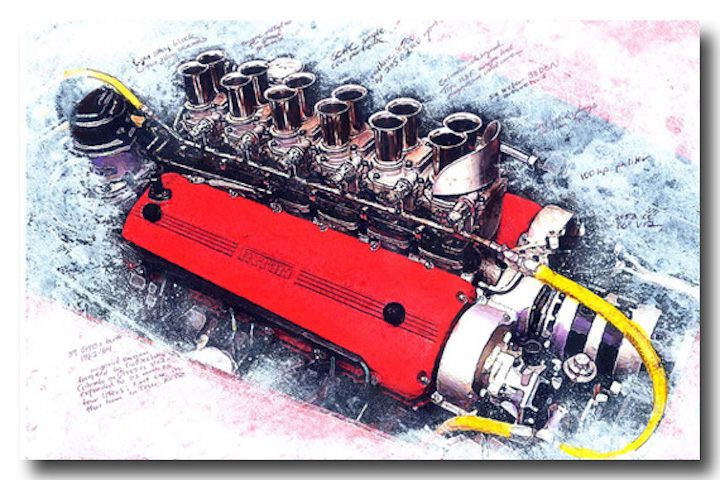

a caption missed out on the last photo ‘does my car….. look big in this’……… I have loved this car from the early 70’s, a beautiful italian chassis/body with corvette V8 power, what’s not to like, the perfect combination….. I think that I instinctively knew the iso grifo was something very special. it would be in my lottery garage for sure…… a nice write up too. thank you
I believe my quote was something like “look at the rear end on the blue one”. Of course I was talking about the blue Grifo. My camera is still smoking.
As an avid collector of Classic Italian 1:18 Scale Models, can you give me your opinion on the BoS Iso Grifo ? Has anyone else ever made a 1:18 Grifo that you know of ?
Is the BoS quality comparable to Kyosho ?
P.S. My selection for a 1:18 Maserati Ghibli (circa 1970) appears to be limited to the Minichamps. Opinions ?
The Kyosho Ferrari 250 GTO High End & Lamborghini Miura SVJ are great in my opinion.
Thank You for your help.
Mark C.
Mark C.,
Sorry I do not know much about scale models. Maybe someone else can help?
Beautiful cars! I find the history behind these cars to be fascinating.
What a collection of some sexy and very classy cars! I love the shape of these classic 1960s and 1970s cars, so much sleeker than modern-day cars. The Iso Grifo Series I is probably my favorite – it’s just such a beautiful car.
Mike, it was good to see at the Concours this year. We were very pleased to bring the A3/L Prototype to the event and to meet all the Iso owners and Peiro Rivolta-Barberi. Your efforts to keep Iso Rivolta in the news is greatly appreciated.
g’day,
I’ve just reread your article & reconfirmed to myself that my love for the iso grifo is not misplaced. the combination of the most beautiful engine sound in the world (& corvette to boot) with the very best of delicious Italian styling is, as you say, un-paralleled…. the only comparison I would give is the understated Gordon – Keeble, again corvette power, Italian styling, with the added joy of an english interior….p.s I first was aware of this car & still remember the photo in the ’64 (’65?) observers book of cars.
thank you for the article
Michael,
It is likely not a coincidence that the GK1 seems so similar to the Iso Rivolta GT because John Gordon met Renzo Rivolta in the early 1960s and gave Mr. Rivolta, and some of Iso’s engineers, a ride in his new creation before the Iso Rivolta GT was designed.
The GK1 chassis was also left with the Iso engineers for study for a brief time.